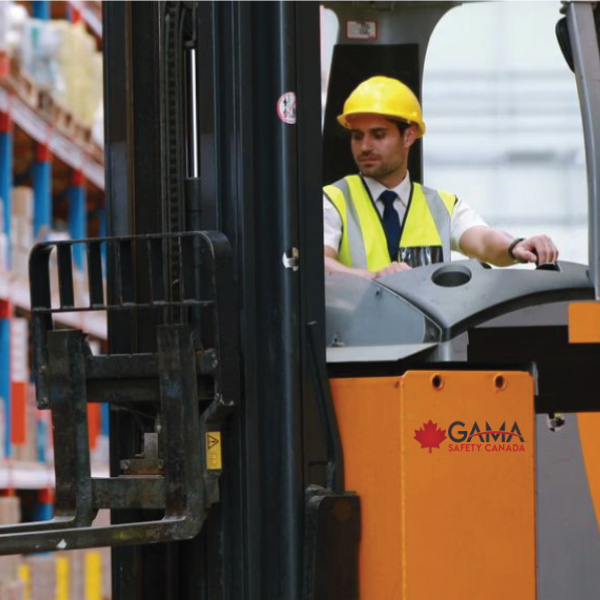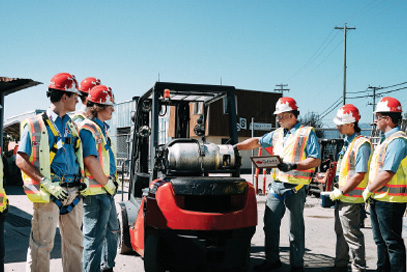Safe Operation of of Stand Up Reacher for Improved Material Handling.
The Stand-Up Reacher is a valuable piece of equipment for reaching high shelves or picking orders in a vertical storage system. Operators should be trained to safely maneuver the machine, ensuring that they maintain stability and balance while reducing the risk of tipping or accidents.
Stand Up
Reacher Basics
Understand the fundamentals of Stand Up Reacher operation, including posture, visibility, and starting procedures.
Turning
& Lifting Safely
Learn how to perform safe turns, control lift height, and manage loads efficiently with a Stand Up Reacher forklift.
Stand up Reach Resources & Guides
Requirements for operator qualifications and responsibilities when using mobile equipment.
Standards for safeguards, protective devices, and modifications of lift equipment.
Rules for lift truck stability, including load limits and safe operational practices.
Safe Operation of of Stand Up Reacher for Improved Material Handling.
The Stand-Up Reacher is a valuable piece of equipment for reaching high shelves or picking orders in a vertical storage system. Operators should be trained to safely maneuver the machine, ensuring that they maintain stability and balance while reducing the risk of tipping or accidents.
OUR PARTNERS AROUND THE WORLD
OUR PARTNERS AROUND THE WORLD
OUR PARTNERS AROUND THE WORLD
OUR PARTNERS AROUND THE WORLD
OUR PARTNERS AROUND THE WORLD
Stand Up Reacher Essentials:
Staying Safe While Operating Lift Equipment
Operating a Stand Up Reacher requires precision, awareness, and a strong commitment to safety. These narrow-aisle lift trucks are designed for efficiency in tight warehouse environments but come with unique risks due to their vertical reach and limited operator visibility.

POWER TOOLS
Stand Up Reacher Safety Overview:
Best Practices and Safety Tips
Operating a Stand Up Reacher forklift requires a deep understanding of equipment functionality, workplace hazards, and the importance of consistent safety protocols. These lift trucks are commonly used in warehouses and distribution centers for stacking, retrieving, and transporting pallets in narrow aisles. While they are highly efficient, they also pose significant risks if not used properly.
To ensure a safe working environment, operators must be trained in pre-operation inspections, safe driving techniques, and load stability principles. Proper positioning, visibility awareness, and adherence to speed limits are critical when navigating tight spaces or lifting loads at height. It’s also essential to use the equipment only on flat, stable surfaces and avoid any sudden movements that could compromise balance.
Employers should implement a comprehensive safety program that includes operator certification, routine equipment maintenance, and hazard identification strategies.
STAND UP REACHER Definition
A Stand Up Reacher is a type of electric-powered forklift designed specifically for indoor use, particularly in environments that require compact maneuverability and vertical lifting capabilities.
Unlike conventional forklifts that feature a seated operator position, the Stand Up Reacher is built with a standing operator compartment, allowing for greater agility, faster dismounts, and improved visibility during operation.
The name "reacher" comes from its ability to extend its forks forward through a hydraulic reach mechanism, enabling the operator to place or retrieve pallets that are positioned deep within racking systems.
This forward reach functionality reduces the need to reposition the entire vehicle, making it ideal for use in tight warehouse aisles, where space is at a premium and precision is essential.
Thanks to its electric motor, the Stand Up Reacher produces zero emissions, making it a clean and quiet solution for material handling in controlled environments such as food storage, pharmaceutical warehouses, and retail distribution centers.
Its versatility, efficiency, and operator-friendly design have made it an industry standard in modern warehousing.
While both machines are used for lifting and transporting materials, the Stand Up Reacher differs significantly in both design and application when compared to a standard sit-down forklift.
The most notable difference is the standing operator position, which enhances operator responsiveness and allows for faster mounting and dismounting—ideal in fast-paced, high-turnover operations.
Additionally, the Stand Up Reacher is equipped with a mast that can extend forward independently of the truck’s frame. This means that operators can “reach” into pallet racks to retrieve or deposit goods without moving the entire truck forward, reducing aisle width requirements and increasing storage density.
Regular forklifts generally require more space to maneuver and often must be fully aligned with a load before lifting, which can slow down operations and limit storage configurations.
Moreover, Stand Up Reachers are typically electric, contributing to quieter operation and reduced environmental impact, whereas standard forklifts are often powered by internal combustion engines, which are noisier and generate exhaust.
These differences make the Stand Up Reacher not just an alternative, but a highly specialized piece of equipment designed to meet the complex needs of today’s high-volume, space-optimized warehouses.
Stand Up Reachers are primarily used in indoor environments where space efficiency, vertical lifting, and maneuverability are critical to operations.
They are most commonly found in warehouses, fulfillment centers, distribution hubs, and cold storage facilities—anywhere that high racking systems are utilized and narrow aisles are standard.
Retail chains, grocery wholesalers, and manufacturing plants also rely heavily on these machines to organize, retrieve, and restock products quickly and safely.
Thanks to their compact frame and electric power source, Stand Up Reachers are particularly useful in settings where emissions and noise must be minimized, such as in food handling or pharmaceutical storage environments.
In automated and semi-automated facilities, they often work in coordination with inventory management systems, barcoding, and warehouse software to ensure efficient material flow and real-time stock accuracy.
Their role in maximizing storage capacity while ensuring safe, rapid retrieval of goods makes them an essential tool in logistics and supply chain operations.
The signature feature of a Stand Up Reacher is its hydraulic reach mechanism, which allows the forks and mast to extend forward an essential function that sets it apart from other types of forklifts.
Here’s how it works: the forks are mounted on a carriage that can be moved forward using hydraulic cylinders. When the operator activates the reach control, the carriage glides outward from the base of the truck, enabling the forks to engage pallets placed within deep racks or double-deep storage systems.
Once the load is secured, the forks are retracted back toward the mast, repositioning the load closer to the machine’s center of gravity. This reduces the risk of tip-overs and improves balance while transporting.
Many models of Stand Up Reachers also feature side stabilizing legs or outriggers, which provide additional support during high lifts or heavy loads, compensating for the narrow wheelbase.
Some advanced versions even include tilt mechanisms and camera systems to aid the operator in safely aligning with high rack positions.
This "reach and retract" system is vital for optimizing warehouse space and allows operators to work efficiently in environments with limited aisle clearance.
Absolutely. Operating a Stand Up Reacher requires specialized training due to its unique design, control layout, and operational risks.
Unlike conventional forklifts, the Stand Up Reacher requires the operator to perform complex maneuvers in tight spaces, often while raising or lowering loads to significant heights. This introduces multiple safety considerations, including the risk of tip-overs, visibility challenges, pedestrian interaction, and potential for equipment damage.
Training programs must cover a wide range of topics, including pre-operation inspections, stability principles, safe driving techniques, and emergency procedures.
In Canada, training must meet the standards outlined in CSA B335 – Safety Standard for Lift Trucks, as well as relevant provincial occupational health and safety regulations.
Employers have a legal obligation to ensure that every operator has received both theoretical and hands-on practical training, and is certified to use this type of equipment.
At Gama Safety, we provide comprehensive training that equips workers with the knowledge and confidence needed to operate Stand Up Reachers safely and efficiently, while complying with all regulatory requirements.
The weight capacity of a Stand Up Reacher depends on the specific make and model, but most commonly ranges between 2,000 to 4,500 pounds (approximately 900 to 2,000 kilograms).
However, it's critical to understand that these ratings are based on standard conditions and are subject to change depending on several key factors:
- Lift height: As you raise a load, the forklift’s center of gravity shifts, reducing its stability and lifting capacity.
- Load center distance: Loads that extend beyond the recommended center (usually 24 inches from the fork face) reduce the truck’s safe capacity.
- Reach extension: When the forks are extended forward, the effective lifting capacity drops due to leverage and reduced stability.
For this reason, all Stand Up Reachers are equipped with a load capacity data plate that specifies allowable weights at various heights and reach positions.
Operators must be trained to read and follow this information at all times. Overloading, improper load positioning, or attempting to lift beyond the rated capacity can result in severe accidents, equipment failure, or tipping.
Routine maintenance, inspection of hydraulic systems, and adherence to manufacturer specifications are also critical to ensuring the long-term safety and performance of the Stand Up Reacher.
STAND UP REACHER Legislation
In Canada, the operation of Stand Up Reachers is governed by each province or territory’s Occupational Health and Safety (OHS) legislation, which sets the minimum safety requirements for mobile equipment, including electric lift trucks. These laws include:
WorkSafeBC OHS Regulation Part 16 in British Columbia
Regulation 851 – Industrial Establishments in Ontario
Alberta OHS Code Part 19 – Powered Mobile Equipment
COHSR – Part XIV for federally regulated workplaces
The legislation requires employers to ensure that Stand Up Reachers are operated safely, maintained regularly, and used only by trained and competent operators. Many jurisdictions reference CSA B335-15, which is the Canadian national safety standard for lift truck training and operation.
Yes. All Stand Up Reacher operators must complete training before using the equipment. This is a legal requirement under OHS regulations in every Canadian jurisdiction. Training must include both theory and hands-on practice, and workers must be evaluated for competency.
The training should follow the CSA B335-15 Standard, which outlines knowledge, inspection skills, load handling, and safe operation procedures. Employers must keep written proof of certification. Allowing untrained staff to operate a Stand Up Reacher can result in serious legal consequences.
Employers are required by law to ensure Stand Up Reachers are used and maintained safely. This includes:
Providing proper operator training and certification
Conducting regular equipment inspections and servicing
Performing site-specific hazard assessments
Enforcing safe work procedures and supervision
Employers must also ensure the visibility of decals and data plates, and that operators are competent. Failing to meet these obligations can lead to fines, stop-work orders, or prosecution if incidents occur.
The safe and legal operation of Stand Up Reachers requires the following documentation:
Operator training certificates and competency records
Daily inspection checklists signed by the operator
Maintenance and service logs for mechanical upkeep
Visible load capacity charts and instruction manuals
Incident reports in case of accidents or near-misses
These records must be accessible for regulatory inspection and retained according to provincial guidelines.
Yes. Before using a Stand Up Reacher, operators must perform a pre-use inspection to ensure the equipment is in safe working order. This is required by OHS laws across Canada.
Inspections typically check:
Brakes, steering, horn, and lights
Hydraulics and mast function
Tires, forks, and load backrest
Battery condition and fluid levels
Findings must be recorded on an inspection checklist. If any defect is found, the equipment must be taken out of service until repaired.
Non-compliance with Stand Up Reacher legislation can result in:
Fines or administrative penalties issued by provincial regulators
Stop-work orders or seizure of unsafe equipment
Criminal charges under Bill C-45 if negligence leads to injury or death
Higher insurance costs and civil lawsuits
Damage to the company’s reputation and contracts
To prevent these outcomes, companies must strictly follow safety laws, provide proper training, and maintain complete documentation.
Other Courses You May Be Interested In.
Workers who complete STAND UP REACHER training often continue their safety education with the following programs:"
More Courses
Online Courses
"Explore & Book Online Courses!
Have a Question?
"We’re here to help! Click the button to get in touch."


